It’s been rough these last few years.
I felt like if I had anything I wanted to say, I couldn’t find anyone who wanted to hear it.
Now I’m deciding if an audience is even necessary.
Here’s a current project, named #hashtag.
It’s been rough these last few years.
I felt like if I had anything I wanted to say, I couldn’t find anyone who wanted to hear it.
Now I’m deciding if an audience is even necessary.
Here’s a current project, named #hashtag.
Employment
Coffee
Coffee culture
Stuffed animals
Home heating oil
A full refrigerator, without requiring a special Thanksgiving shopping trip
Sweaters
Books
Wine, a gift from a friend
Vintage quilts
Great finds at the Goodwill
My roommate Dustee
My ex-husband not calling me selfish and irresponsible
My own washer and dryer
Silence
The hum of the furnace that breaks the silence
Wifi
The feeling of safety
Loneliness that drives me to interact
The power to act – or to not act
Fear of failure
My bed. I have a really good bed.
I suppose it started right after Heather was born. I was drunk with the physical reality of motherhood. My body had been transformed; mind and spirit had to change, too, to keep up.
We were driving east up 67th toward Phinney, and I saw a man walking in the sidewalk. He was just a man. Some guy walking down the street. He wore an army green coat with faded jeans, hands deep in his pockets to keep out the January drafts. Worn out ankle high hiking boots in an indescribable shade of drab. His shaved bald head had a thin coating of now grey hair.
That bald head in the cold looked so much like my new baby’s. For a split second I saw him as his mother just have, just a few weeks after his birth. I wondered how that giant adult body held up a weak, newborn’s heavy head. Then he took another step and he was a middle aged man again.
For the rest of the day I was lost in that immediacy of motherhood. Everyone I saw was someone’s newborn.
I never quite recovered.
How do you get angry with someone, even someone who desperately deserves it, when in the blink of an eye you can see them as a two week old baby, utterly dependent on others for survival?
And aren’t we all?
So you know I’ve been hitting the stranded knitting pretty damn hard. Do I pick up one of my WIPs and get to work? Of course not.
I rummage around for some plain white wool, and some beads. I’ve never done beaded knitting. Never really interested, except that one time I put beads on the bind off of a small garter stitch shawl. (oh, I knit that. I’ll show you some time soon.). But for some completely off the wall, out of the blue reason, I have to mix my beads with my yarn. Crazy, I know.
I wanted to demonstrate some Other Ways to use charts in knitting. That’s what I wanted to do. So I pulled up a page of small motifs from my mitten design class, and cast on 36 sts in some natural white Rauma Finnullgarn. Joined in the round, two garter stitch ridges, and off I go with the beads. It looks like this.
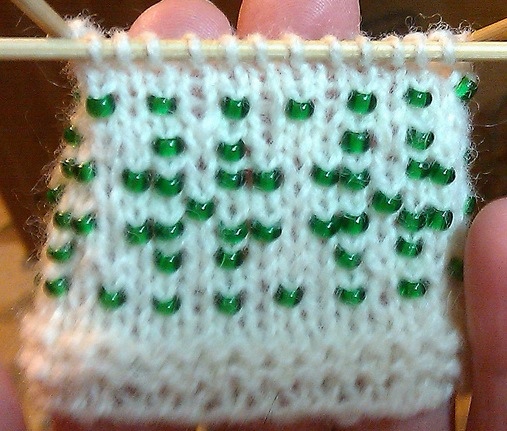
Like every self proclaimed expert, I love to have my expertise validated with a request for consult or counseling in my area of choice. When Hélène Magnússon emailed me asking to help her identify the origin of some gloves and mittens she’d seen in an Icelandic museum, I was flattered, and happy to help. I can’t confirm from a photograph where a particular piece was made, or when, but I can tell from the style and construction details what knitting tradition inspired its creation, and that was sufficient info for Hélène.
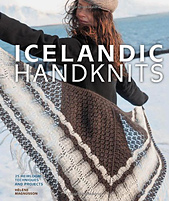 As thanks for helping her confirm Selbu as the source for some of the items that inspired her, Hélène sent me a promotional copy of her new book, Icelandic Handknits. And it’s a gorgeous book. Hardback, full glossy pages, rich, full color, I love the sensual aspects of books; I think that’s why I prefer publishing on paper myself, and rarely read anything longer than a news article or blog post on my digital devices.
As thanks for helping her confirm Selbu as the source for some of the items that inspired her, Hélène sent me a promotional copy of her new book, Icelandic Handknits. And it’s a gorgeous book. Hardback, full glossy pages, rich, full color, I love the sensual aspects of books; I think that’s why I prefer publishing on paper myself, and rarely read anything longer than a news article or blog post on my digital devices.
Later, when she asked, I was only too happy to write a piece for her blog tour.
Many book reviews are elevated levels of metadata about the book. Who wrote it, who that author is personally, where they came from, how big the book is, what’s inside. Which designs are the reviewer’s favorites. I wanted to do something different. As a designer, I need to know how my work affects the reader. I’m well known for my love of traditional design, and I found many projects I’d love to make for myself. For this blog tour I decided to review the book as a knitter, not another designer, and think about what I wanted to knit first. I chose three projects, marking their places in the book with sticky notes.
Many of the designs are, expectedly, knit in lopi, the Aran weight staple of Icelandic knitting. I have a considerable yarn stash, but lopi is too hot and heavy for Seattle. I’d need to substitute.
A methodical stash dive was called for.
A few years ago I bought the white plastic grid racks you see in many yarn stores, and I organized my stash by color. I knelt down on the floor in front of the racks and pulled solid colored Aran and worsted weight wools and wool blends onto the floor in a big pile.
Within fifteen minutes I had a wide range of brands of yarn to choose from. But the choices were limited: almost all of the yarns that met the weight and color requirements were natural wool colors; browns, greys, creams, white. All neutrals, not a spot of color anywhere. A sea of bland; an ocean of Pay No Attention To Me. I am not here. You can’t see me: I’m invisible. Color informs and reflects our emotion. I bought those yarns. What did that selection say about me and my state when I purchased them? Was I looking at my own self hatred, depression, disappointment in a life turned sideways from where I wanted it to go?
And what does it say about me as a designer? I have a reputation, I think, ( I hope) of creative and inspired use of color. I buy yarns for work in brilliant shades. When I started doing the stranded stuff, I bought one ball of every shade of Rauma Finnullgarn. That’s a hundred balls of yarn. It’s a lot of yarn. I mix purples with olives, teal and orange, yellow and orange and red and green. But when it comes to my own private stash, all I can come up with is baby shit brown?
There must be some mistake. Clearly a change would be in order. I can’t just have brown and grey and cream and black and maybe a touch of blue or red now and then. I have a reputation to maintain. I am A Professional.
Then I looked at the book again, with its gorgeous four color, glossy photographs of beautiful, windswept people, in a beautiful, windswept environment. Colors are rampant: vivid green fields, blue skies reflected on water and ice, a red door. The garments, though, tend to stay neutral in color, with vivid highlights, styled with colorful accessories. Look at the ladies cardigan Skautbuningur on page 60, styled with a bright cotton print dress, against that red door, is black with an old gold patterned border. The one Lopi sweater, modeled in a man in page 74. Navy blue with a simple red checkerboard at the yoke.The Motull capelet on page 66, which my imagination repurposes in scarlet with a hood, is deep forest green and a black border pattern.
Even accessories such as scarves, shawls, mittens, and socks are neutral colored; Bright shades seem restricted to borders or cuffs, or hidden inside in shoes.
Back to the material. By this time I’m a nervous wreck. I am clearly in deep psychological distress, because I have a pile of brown and grey and cream yarn in front of me. I scan through the photos of old costumes. Hélène selected those photos, with the help of her editor and art director. My inner expert pipes up. It’s not me: this a reflection of Helene’s state when she designed the projects. She must, by my logic, also be in deep psychological distress. Is she depressed and filled with self loathing? Is that all that brown can mean? Or is this color choice reflective of the traditional Icelandic clothes which provide the inspiration for the book? I have to consider that her filter is always in place, when looking at the focus piece of the photo, but I might get past it by looking at what’s in the background.
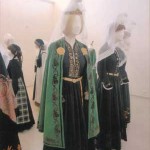 Sure enough, the traditional costumes are dark or natural colored. An occasional red plaid skirt, a paisley shawl.
Sure enough, the traditional costumes are dark or natural colored. An occasional red plaid skirt, a paisley shawl.
So then I look back at my own yarn selection and by some miracle I step back from my perspective. I find some scrap of objectivity. Why am I dissatisfied with the selection that follows the designs in the book? Why did I remember the designs as brightly colored, and think it was my yarn selection that was faulty? Is there anything at all RIGHT with me? Is it me? Is it you? How can I tell the difference?
Clearly I’m thinking too much about my yarn colors.
I’m composing this post on my iPad, in a coffee shop, and I wonder now about the clothes we look at and the clothes we wear. Aside from the employees, who wear a uniform, only two people are wearing vivid colors, and I am not one of them. Both of them are men, and both of them are in tee shirts and jeans. Other colors on other patrons are muted; black, lavender, grey, dusty coral, soft blues. Textural emphasis replaces color in some outfits; a tweed, a heather, softly toned plaid. This is a fishing village, and the people are wearing comfortable, soft, easy care clothes. I am the most formally dressed person here, in brown leggings and a hand knit silk and kid mohair yoga dress, knit circularly from the top down. There’s a bow on the left shoulder.
In the past, people wore something much more like a uniform than we’d be satisfied with. The traditional women’s costumes in the book all follow the same format: white blouse, black bodice and skirt, colored apron. Each piece may be, or may not be, decorated with embroidery or colorful trim. Modern western people expect to be able to pick and choose their wardrobe from a wide range of styles, shapes, and colors. The wardrobe is a personal expression, and we want to express something different every time we get dressed. Today I wear a yoga dress, but tomorrow I might wear a top inspired by a Victorian corset, and the day after I might wear an ancient Grecian style full length dress. Or maybe I’ll go with jeans, boots, and a leather jacket to express my tough side. All of history is open to me as a starting point. Fashion is a language, and I want to say a lot, even if I don’t know exactly what it is that I’m saying.
It wasn’t always so complicated.
With all of those choices, however, when I look around, I see people all wearing the same basic thing: jeans, a tee shirt, and some kind of jacket. Low shoes. Women may carry a handbag. Some older women accessorize with a scarf or long decorative necklace to draw the eye away from a softer, fuller figure that is currently unfashionable.
My panic subsides. Maybe it’s not me, or at least not in the way I was thinking in the moment I looked at my yarn pile and saw a pile of baby poop colored yarn. And then it comes back in a new form. Am I really so insecure that I think I can be reduced personally, emotionally, spiritually, intellectually, philosophically, to a single idea, represented by a single color? I’m stuck in a recursive loop: do I see what I see, or do I see what I think you’ll feel about what I see, and judge myself accordingly?
In the end, what I see and what I create is a reflection of some element within myself. When I work from my own creative source, aware of my self limitation and criticism – did I pick the right yarn – and looking past the focus to the real subjection my mental photography’s background, I’ll produce something authentic.
What’s wrong, after all, with my collection of natural colors yarns? Many of them are farm yarns, purchased directly from small local producers, that money going right back into their farm to produce next year’s crop. They’re undyed, minimally processed, with the rich hand and scent of the land and creatures that produced them. The colors are muted, but each has a subtle texture different from the others: one crisp Romney would make perfectly formed, neat stitches with strict definition. Another unspecified wool has a modest but nubby tweed. Still another wool blended with alpaca rises up with a subtle halo. They are beautiful. I love my brown and grey and cream yarns. I love how they make me feel; they take away the hard edge of emotion. They’re a visual buffer, a layer of padding between me and the emotional armor that life as an adult forces me to wear, out of sheer self preservation.
It’s freaking yarn. It’s not the end of the world. It’s just yarn.
I look around at the modern world, full of bright colors and perfect manufactured goods, and everything seems to fit within a perfectly fitted space, and I can’t find a space for myself at all. Maybe my selection of natural farm yarns reflects a desire for more quiet, more authenticity than I see sitting on this busy intersection. Our eyes and brains evolved in a natural environment of grey stone and brown earth and green field and blue sky, and the brightest hues in nature tend to be as sparingly visible as the scarlet or amber trim on those old clothes in the museum. Even at the height of the season, a field of tulips here in the Skagit Valley is still mostly brown soil, green stems, blue sky, and a stripe of red, yellow, orange, or purple.
Colors affect us, physically and emotionally. It’s not my opinion, it’s established scientific fact. Maybe what Hélène and I are both reflecting is a desire for a more natural lifestyle, in the shades that time evolved our eyes and brains to expect. Maybe my brown yarn yarn is where some self protective instinct kicked in, unannounced, to shield me from a too-bright modern world. My jangled nerves need soothing.
This is where my reading of a knitting book takes me: through the materials and back to myself.
What’s on your needles?
Maria asked me,
I was asked why I didn’t knit to sell when I was unemployed during the worst of the great recession. I said it was because nobody I knew could afford $500 sweaters. I don’t design, so there’s also the issue of using others patterns, which nobody got, either.
I think it’s most economically feasible to sell patterns to knitters rather than hand knit garments to non-knitters. Have you tried figuring out how many patterns you’d have to sell at, say, $8 to break even for designing one?
And that’s the entire point of this mini series on cost estimating my projects.
Let’s review one of my more successful single patterns: Kitty Selbu. This mitten pattern was inspired by my cat’s healthy scare. (Note: we lost the kitty, eventually.) The pattern sells in my Ravelry store for $6.00. For simplicity’s sake, let’s look only at the Ravelry sales, which accounts for the vast majority of my single pattern sales.
I have grossed $570 in Ravelry sales on this pattern since November 2010.
I have made many pairs of Selbu mittens, so I can, from my experience and the time tracking I performed on the mitts, estimate that I spent about 30 hours labor on these mittens, and an additional 3 hours in photography, layout, and publishing. At my bare minimum wage, that’s an estimated $330 invested in the creation of this pattern.
Leaving aside costs that a business would normally need to include, such as office space to work in, electricity to run the lights and computers, and so forth, I can then calculate that I have profited $240 from the sale of this one pattern. Since November 2010.
So to answer the basic question, I would need to sell 55 patterns at $6 to break even.
This begs the question: what is a pattern worth? How much can I charge for a pattern, to increase my profits, before I drive away sales with a too-high price tag?
Let’s do some more competitive analysis. This time I’m focusing on patterns, and for that, I go to Ravelry.com.
This table contains the top nine most popular for-sale mitten patterns.
These are the most popular for-sale patterns. There are several ways I can interpret this review. $6.00 seems to be a reasonable price for a mitten pattern.In fact, it’s fairly median.
Another observation is that most of these patterns are worked in worsted weight yarn, and decorated with a texture pattern rather than colorwork. People buy what they want, so knitters apparently prefer textured mittens at a larger gauge to fine stranded work.
But there’s a larger point that only reviewing for-sale patterns completely overlooks.
Of the top 25 mitten patterns on Ravelry, only nine of them cost money. The other 16 are free.
I can surmise from this that knitters are willing to pay a small price for a pattern that suits their preferences – textured worsted weight – but most would choose a free pattern over a paid one. In fact, only seven of the top twenty five used colorwork in any technique at all, aside from very large stripes or self-striping yarn, and of those, only four used stranded knitting.
My patterns don’t even show up in the top 100 most popular designs.
So why is that?
This comment expresses the feelings of many craftspersons. I do what I love because I love to do it. How do I make it pay off?
I have just recently taken up crochet again now having found extra time. I find myself thinking of one person as I work an item. I made a prayer shawl for a friend that was going through a trying time, a poncho – hat – muff set for a niece and a collection of assorted throws and afghans for my adult children. I find crocheting to be better than any of the medicinal routes I have traveled, it calms me and I find it quite therapeutic. Especially when working with colorful and textured yarns. While I may be thinking of a particular person while I am creating it, that doesn’t always mean the person will receive the finished work. It’s more like I am drawing from their person or personality and revisiting memories. The prayer shawl mentioned above is going to a fellow crafter so I know it will be loved and my niece absolutely adores the set.
That said; I find it very difficult to even consider giving up a completed item. It’s like I have this connection to the finished work that I don’t want to let it go. I can’t imagine some of the “potential recipients” appreciating the time, thought and cost that I put into an item. In my minds eye I see it carelessly laying on a floor or hidden in a closet or… *shudders* tossed away:(
I started thinking that maybe if I put a cost on it and sold it that I would find someone who would be willing to pay a price that would insure it be appreciated as the creation of it intended. So I looked to Etsy and started doing some research.
I was appalled that someone could sell a throw or shawl for 80$ when I knew the cost of yarn had to of been more than half. It depressed me to think these beautiful things created by loving hands were being treated so cheaply. If that is all someone would pay then certainly my worst fears would be true and after a short time my beautiful item would be carelessly tossed aside.
My husband thinks I am crazy as I just create and fill “space bags” with these finished beautiful things. He does however realize it is a passion to me and respects the time I put into them (not to mention, he likes the calm;). He just doesn’t “get” the attachment I feel and thinks I should sell them for whatever I could get.
After reading a lot of these posts I think that maybe I WILL try to put a few items on Esty at prices I know will be a lot higher than the norm but will appease me and hopefully insure that the item is appreciated as intended. After all; I suppose if they don’t sell, I still have plenty of space bags and storage… right?
There are two reasons for doing crafts: because you enjoy it, or because it’s your job. When I do a project that communicates my own internal vision, that is art. When I do a project that communicates someone else’s vision, that is commercial design. It may be beautiful, meaningful, full of fantastic symbology or measurable qualities, but if I’m implementing someone else’s vision, it’s a design, not an artwork.
When I create a design for publication, I go into it knowing that this piece is not for me. It’s not art, even if I come up with everything about it: the colors, shapes, textures, and so forth. It is a piece of commercial work, and so I distance myself from it emotionally. I know that when I send a sample to a magazine, for example, that I won’t likely get it back, and that it will be manhandled, steamed, perhaps cut to fit onto the model in the way the photographer wants (it happens) and then shipped to innumerable yarn stores in a trunk show. Or it may sit in a box for the next twenty years. Or it may be sold for the cost of the yarn. I don’t care, because it doesn’t belong to me. It’s not my art, it is a design that I created for the specific purpose of being manhandled, cut, shipped, and so forth. I’m not invested in it emotionally. It doesn’t hurt.
What does hurt is when I make something special for someone who knows me, and that person treats my work carelessly. It feels like an insult. That is ME that I put into that sweater you’ve just tossed into the corner. I made it for YOU to express my love, and you’ve tossed it aside. Is it my love that you’ve tossed aside? My effort? Or do you just not care about the effort, or not recognize it?
As craftspeople, we have to be aware that most people don’t know or even care how hard it is to make stuff. We have to distance ourselves emotionally, or every time someone tosses their sweater in the corner, we’ll feel like they’re rejecting us personally, even if they’re not. I have knits that other people made and gave to me, and I keep them in a basket with the rest of the hats, scarves, and so forth. I treat them a little better than my store bought things, but really, I don’t treat my own knits like they’re spun gold or something. These are my clothes, and I wear them, and eventually they wear out and need to be replaced. They are designs, not art.
There is also an interesting point in our work, and I think it’s largely a cultural expectation that if you do something, and do it well, you should be able to make money at it. Americans largely define themselves by their job. When you meet someone, it’s the first question that gets asked: So what do you do? And by that they mean, of course, what is your job or renumerative activity? How do you earn your living?
When someone asks me if I sell my knitting, I try to remember that they think they’re complimenting me. They think that what I’m doing is worth something, which means worth something financially.
I don’t personally believe that everything we do needs to be an income earning activity, but I try to appreciate the intended compliment.
To craftspeople who are thinking about selling their work: you have to decide if your pieces are art or design. If you don’t mind them being treated the same as store bought items, then you’re ready to sell. If you shudder at the thought that someday your item made by loving hands will wear out, then you should find a really good charity or orgainzation to give them to. People who will appreciate that this is your meditation, and the things you make are not just some old things you’re going to wear out and throw away.
In the interest of complete honesty: I rarely knit for my daughter anymore because she throws my beautiful handmade things on the floor, or takes them to her father’s house and I never see them again. I knit samples to sell patterns, and I keep the samples as neat as I can. I knit for myself. Sometimes I knit for a fellow knitter. When the time comes that I can find a market that will pay me what my time is worth, I’ll knit for sale. But I won’t mistake art for design. It’s just a sweater. It’s just a sock. It’s not rocket science.
Or, Mining Etsy: A follow up to my previous post.
After calculating the cost in time and materials to create a simple project, like the pair of mitts, I started thinking. How much effort do I need to put into a knitted item, to receive a decent price? If I am going to invest 20 hours, or 40 hours, what kind of item would it need to be, to motivate someone to spend their hard earned money on it?
I’ve already calculated my rate at $10/hr, for the sake of argument. So I went back into Etsy and looked around.
My initial search query was simply, “handknit,” and this pulled up a standard results page with over 19,000 hits.
But I’m not just interested in what sellers are listing. I want to know what they’re selling, and for how much. I sorted the results by price, highest first, and started clicking into each item.
Each item page has a box about the shop, which is generally the artist him or herself. This profile includes a feedback line, which links to every feedback the seller has received, good, bad, indifferent.
This is the data I want to find. What are buyers actually buying? Here is a crop of the feedback page for the above seller.
The item page doesn’t display the price it was actually sold for, only that it was sold.
But if you look in the display ads above the main product image, you see similar items from that seller which are currently listed, and from that we can estimate what this item sold for. Comparing it to the other jackets shown above, I figure she probably got around $500 for this scrumptious bit of fluff. Not bad work, as it is probably knit at 2.5spi, which means she could get through it in a few days.
I spent an hour or so, clicking through the listed items, then to the seller’s feedback page, and then to the sold items, then comparing them to similar items currently for sale. Here is a short list. You’ll have to copy/paste the links.
—
http://www.etsy.com/transaction/100644624
Cotton dress $450
http://www.etsy.com/transaction/101435560 – short sleeved women’s pullover, some stranded, chunky gauge $140
http://www.etsy.com/transaction/93398375 – long sleeved women’s pullover, linen stitch? or tuck stitch $250
http://www.etsy.com/transaction/97728698 – crocheted shawl, large squares, wool $115
http://www.etsy.com/transaction/92666659 – plain socks. $39.50
http://www.etsy.com/transaction/101653876 – ultrachunky multicolored, textured coat. ~$550
http://www.etsy.com/transaction/67861536 – mitts in simple stranded patt. $50
http://www.etsy.com/transaction/92909982 – 57×74″ afghan, Bernat acrylic $380.
she has sold several (15 in feedback)
http://www.etsy.com/transaction/114437232 – Silk merino lace cardigan, sport or DK weight $220
http://www.etsy.com/transaction/103968767 – aran coat, worsted weight. $360
http://www.etsy.com/transaction/98946720 – simplified aran pullover $240
http://www.etsy.com/transaction/98015856 – chunky seed stitch cardi $275
http://www.etsy.com/transaction/91034305 – short row garer cardi, chuncky $220
*many* sales, items and patterns
http://www.etsy.com/transaction/96488230 – traditional cowichan. $350
http://www.etsy.com/transaction/91420980 – cashmere wool shawlette, lace.
she has many sold items, but they seem to be from commercial patterns or one-offs. Price range $~85-300
—
What can I conclude from this very brief survey?
First, that people do sell handknit items for several hundred dollars. And not one or two, but many. So there is a market.
Second, that like a sensible knitter, these items seem to be knit at a larger gauge. That makes faster work, and so you can produce more items to sell.
Third, that sellers seem to devise a pattern or a line, and then make those things only. I haven’t seen sellers making a random assortment of items. Either it’s sweaters, with a few accessories in similar patterns and yarns, or like the funky coat above, a single style of garment, in a range of colors, where the garment shaping is secondary to the effects of the yarn. These sellers treat their online store like a business, with a specific product range, which is repeated.
Producing the same thing over and over again might not sound like fun for a hobbyist, but this is exactly what the old Selbu knitters also did: specialize in a small range until you get very good at it, and then your increased speed will improve your overall production quantity.
So what about the pieces themselves? I found a lot of classic styling offered for sale, but the things that people bought were funky, outrageous, bright, bold. Things you can’t find in a store. If you want to knit couture, you have to make something that can’t be found in the mall.
The exception to this rule was an Italian knitter whose pieces are very elegant, with classic shaping and easy yarns. Her work appears to be worsted weight, and worked a little loosely.
And the other knitters I surveyed today? Also largely outside the US. I found one or two people selling a few pieces from San Diego or the south, but most of the sellers were from other countries.
Etsy can provide a wealth of information, if you can spend a little bit of time mining the data the old fashioned way. By hand.
I’ve been asked recently if I sell my handknits, and how much they would cost. I don’t and I don’t know how much, so I decided to find out.
First I installed this wonderful iPhone app, Timewerks, written by a former colleague. It’s an adaptation of the time tracking package we used when we worked together at the webdev shop. He wrote the original, and the company then rewrote it and sold it (I think) and then he wrote a new version for the phone.
I spent a few minutes on configuration, creating the kinds of tasks that I perform when designing and writing a pattern, then knitting the sample. I want to be able to differentiate how much time is spent doing what. I set an hourly rate of $10/hr, just as a simple rate. It makes the math easy. In the future, I can create additional tasks with higher rates. I can even set multiple tasks with multiple rates, so I can “charge” projects at different rates for the same task. The skill required to design a stockinette cardigan is different than the skill required to design a fair isle pullover, for example, and it would be fair to charge different rates.
I also created billable items for the yarn I am using, 2 balls of Rauma Finullgarn.
Then, I used the Add Hours feature to add in the estimated the time I’d already put into writing this pattern. After that, I used the timer feature to calculate my time spent as I knit.
In design, pattern writing and chart creation, as well as sample knitting, I have spent 10.75 hours. I have also used two balls of yarn I estimate to cost $7.00 per ball. That’s a total of $121.50 in opportunity cost that I have invested in this design.
So what does that get you?
One mitt and ribbing, and a few pages of pattern, roughly produced.
What can I learn from this?
First, I need very wealthy clients to buy my handknits. And that’s why I don’t list them on Etsy.
Second, I can knit a single mitt in ten hours, which is comparable to the old Selbu knitters, and that makes me smugly satisfied.
I’ll need to use the system for several to many projects before I can see trends. How much of my time is spent pattern writing, as in the text versus charting? I have to create separate items for them, and I have to use the system regularly. It’s a nice way to keep track of progress, though.
I can get actual data describing my time, as a professional, on my own tasks, so that when I hire someone, or hire myself to knit or write or tech edit for someone else, I know what to charge.
Update: Here’s one way to use my time estimates in making business decisions about what products I want to make and sell. How much can I sell it for?
I spent the spring putting out a book and a summer knitting a bunch of new patterns (available on terrisheaknits.com) and now I’ve taken a little time off for some relaxation.
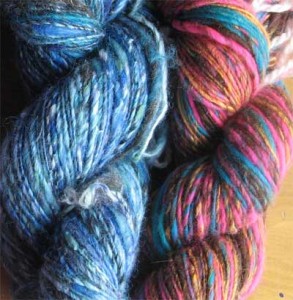 A little spinning. The blue on the left is a soft, balanced single. The Crosspatch Creations Spin Ready Batts from Carolina Homespun were delightful to work with; well balanced without being over blended, and no big clumpy lumps of one fiber over another. The fibers all moved together, beautifully, which made this single ply yarn easy to create.
A little spinning. The blue on the left is a soft, balanced single. The Crosspatch Creations Spin Ready Batts from Carolina Homespun were delightful to work with; well balanced without being over blended, and no big clumpy lumps of one fiber over another. The fibers all moved together, beautifully, which made this single ply yarn easy to create.
The skein on the right was an impulse buy at Sock Summit. I had dragged my wheel along, and by gum if I wasn’t going to use it. I think I got more attention for this than for the class I taught. Ahem. Again, I ended up with a single ply, but this fiber wasn’t as easy to spin as the blue above. The orange fiber is bamboo, and it tended to stick to itself and not blend well with the other. My goal was a funky, eclectic, modern chunky yarn that could be knit into a funky, eclectic, modern chunky accessory. I think I achieved that, although the grist is finer than I expected it to be.
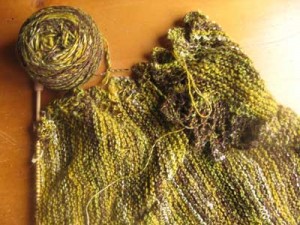 This knitted piece is also handspun. It’s going to be a scarf or stole or wrap or however long it turns out to be. I bought 4 ounces of batts from Emma who dyed as Dragonfibers a few years ago. Moderately aged, it spun up perfectly. I love the olive and brown combination, and am using it in another project, which you’ll see previewed at terrisheaknits.com
This knitted piece is also handspun. It’s going to be a scarf or stole or wrap or however long it turns out to be. I bought 4 ounces of batts from Emma who dyed as Dragonfibers a few years ago. Moderately aged, it spun up perfectly. I love the olive and brown combination, and am using it in another project, which you’ll see previewed at terrisheaknits.com
 A little dyeing. I threw up a pot of logwood, added a whole mess of … Corriedale, as I recall, and some mohair, and waited to see what happened. This purple skein is from the exhaust bath. The fiber is tied up in a bag in the basement and is hiding from me. Because I wanted to take its picture. Sigh again.
A little dyeing. I threw up a pot of logwood, added a whole mess of … Corriedale, as I recall, and some mohair, and waited to see what happened. This purple skein is from the exhaust bath. The fiber is tied up in a bag in the basement and is hiding from me. Because I wanted to take its picture. Sigh again.
 And some brainless knitting. Please be kind to your poor model. I have only myself and a single mirror, poorly placed and frequently used by someone with sticky hands. Sigh. A chunky weight dark grey tweed cowl, made in Mystery Yarn, and a jaunty little beret out of Noro Kochoran. My long time followers may recognize that colorway from the Unibreast Sweater. (Those who haven’t followed me: it was gorgeous fabric that hung just wrong. Yes, I ripped and reknit it.)
And some brainless knitting. Please be kind to your poor model. I have only myself and a single mirror, poorly placed and frequently used by someone with sticky hands. Sigh. A chunky weight dark grey tweed cowl, made in Mystery Yarn, and a jaunty little beret out of Noro Kochoran. My long time followers may recognize that colorway from the Unibreast Sweater. (Those who haven’t followed me: it was gorgeous fabric that hung just wrong. Yes, I ripped and reknit it.)
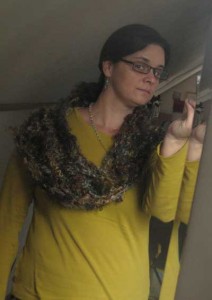 And finally a long cowl, or is it a circular scarf or what is it? I’m not sure. It’s Rosalie Truong handspun mohair, and the colors of green and blue and brown and gold are so scrumptious, I really don’t care what it is. Just don’t take it off me.
And finally a long cowl, or is it a circular scarf or what is it? I’m not sure. It’s Rosalie Truong handspun mohair, and the colors of green and blue and brown and gold are so scrumptious, I really don’t care what it is. Just don’t take it off me.
Back to work on pattern knitting. What are you working on?